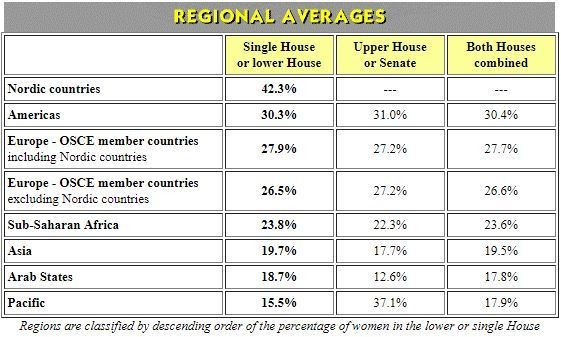Number of Women in the Us House of Representatives
1 of the few things that brought Democrats and Republicans together during US President Donald Trump's recent Land of the Union address was jubilant a record number of women in Congress. Ane hundred and ii women were elected to the House of Representatives in the 2022 midterms, taking 23.5% of the 435 seats.
Simply the Usa still lags well behind much of the world when it comes to female representation – ranking simply 75th on a list compiled by the Inter-Parliamentary Matrimony. In fact, the US doesn't even accomplish the global average of 24.one% of lower house seats won by women.
The land at the top of the list may surprise some. Rwanda boasts by far the best record for female representation in parliament, with nearly two thirds of its seats currently held by women.

Image: Statista
There are only 2 other countries with more women in parliament than men – Republic of cuba (53.2%) and Bolivia (53.1%). Latin American and Caribbean nations also take a further four spots in the acme 10 – Mexico (48.2%), Grenada (46.7%), Nicaragua (45.7%) and Costa Rica (45.6%).
The rest of the top 10 is rounded out past ii more African nations – Namibia (46.2%) and South Africa (42.7%) – and, perhaps unsurprisingly, Sweden (46.1%), the world'south first cocky-proclaimed "feminist" government.
The Nordic group of countries leads the way in female person representation with 42.3% of seats, followed by the Americas (30.three%), the rest of Europe (26.5%) and sub-Saharan Africa (23.8%). Asia (19.7%) and the Arab states (eighteen.7%) lag well below the global boilerplate, only it is the Pacific nations (fifteen.5%) which take the worst tape.

Prototype: Inter-Parliamentary Union
So what is behind the huge differences in female representation?
Quotas are a common factor in many of the electoral systems with more women equally legislators and MPs. The first country in the world to introduce a gender quota past law was Argentina in 1991. Since then the legal requirement for parties to put forward a certain proportion of female candidates has become common across Latin America, and beyond. Many other countries accept adopted different approaches with the same aim, either reserving seats for women (equally in China, Islamic republic of pakistan and many Arab nations), or past political parties voluntarily adopting their own quotas (as in much of Europe).
Quotas have certainly had a dramatic impact on Rwandan politics. In the 1990s on average eighteen% of parliamentary seats were held by women. The constitution of 2003 mandated 30% of elected posts be held by women. By 2008 women fabricated upwards more than than half of Rwanda'due south parliament, and that proportion rose to nearly two thirds in the 2013 ballot.
Over the last twenty years huge steps have been fabricated towards greater female person representation. In 1997 women only held more than 30% of seats in Sweden, Norway, Finland, Denmark and the Netherlands. At present at that place are 49 countries where that barrier has been broken. But since 2022 progress has stalled – and in some cases gone into reverse.
The proportion of ministerial posts held past women remains stubbornly depression, at one in five. France, Canada and Spain take all had cabinets with at least as many women as men. But they are exceptions rather than the rule. And even when women are promoted to cabinet, they are often given inferior roles, and ordinarily restricted to what UN Women calls the "soft issue" portfolios, such as social affairs and family unit.
More than half of the countries in the world accept never had a female leader. Merely even having a adult female at the top is no guarantee of greater representation. Bharat, one time ruled by Indira Gandhi, now has just 64 women amongst its 542 MPs.
Progress on women's political empowerment over the past decade has reversed slightly in Western countries, according to the World Economic Forum'south Global Gender Gap Report. Its political empowerment subindex – which measures the gap betwixt men and women at the highest levels of political decision-making – is where the gender gap remains the widest.

Image: Globe Economic Forum, Global Gender Gap Study 2018
But some women are beating the odds to rise to loftier political office. Germany's Chancellor Angela Merkel, the longest serving female caput of government, has designated some other woman as her called successor. Nancy Pelosi has go the most powerful women in American politics, and the de facto leader of the opposition to President Trump. And New Zealand's Prime Government minister Jacinda Ardern has proved that motherhood is no bulwark to the tiptop chore, condign the second leader in history to give nascency while in office.
Subscribe for updates
Source: https://www.weforum.org/agenda/2019/02/chart-of-the-day-these-countries-have-the-most-women-in-parliament/
Post a Comment for "Number of Women in the Us House of Representatives"